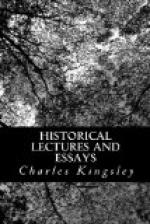{7} A Life of Rondelet, by his pupil Laurent Joubert, is to be found appended to his works; and with an account of his illness and death, by his cousin, Claude Formy, which is well worth the perusal of any man, wise or foolish. Many interesting details beside, I owe to the courtesy of Professor Planchon, of Montpellier, author of a discourse on “Rondelet et vies Disciples,” which appeared, with a learned and curious Appendix, in the “Montpellier Medical” for 1866.
{8} This lecture was given at Cambridge in 1869.
{9} This lecture was given at Cambridge in 1869.
{10} I owe this account of Bloet’s—which appears to me the only one trustworthy—to the courtesy and erudition of Professor Henry Morley, who finds it quoted from Bloet’s “Acroama,” in the “Observationum Medicarum Rariorum,” lib. vii., of John Theodore Schenk. Those who wish to know several curious passages of Vesalius’s life, which I have not inserted in this article, would do well to consult one by Professor Morley, “Anatomy in Long Clothes,” in “Fraser’s Magazine” for November, 1853. May I express a hope, which I am sure will be shared by all who have read Professor Morley’s biographies of Jerome Carden and of Cornelius Agrippa, that he will find leisure to return to the study of Vesalius’s life; and will do for him what he has done for the two just-mentioned writers?
{11} Olivarez’s “Relacion” is to be found in the Granvelle State Papers. For the general account of Don Carlos’s illness, and of the miraculous agencies by which his cure was said to have been effected, the general reader should consult Miss Frere’s “Biography of Elizabeth of Valois,” vol. i. pp. 307-19.
{12} In justice to poor Doctor Olivarez, it must be said that, while he allows all force to the intercession of the Virgin and of Fray Diego, and of “many just persons,” he cannot allow that there was any “miracle properly so called,” because the prince was cured according to “natural order,” and by “experimental remedies” of the physicians.
{13} This lecture was given at Cambridge in 1869, and has not had the benefit of the author’s corrections for the press.
{14} Delrio’s book, a famous one in its day, was published about 1612.
{15} For a true estimate of Paracelsus you must read “Fur Philippus Aureolus Theophrarstus von Hohenheim,” by that great German physician and savant, Professor Marx, of Gottiingen; also a valuable article founded on Dr. Marx’s views in the “Nouveau Biographie Universelle;” and also—which is within the reach of all—Professor Maurice’s article on Paracelsus in Vol. II. of his history of “Moral and Metaphysical Philosophy.” But the best key to Paracelsus is to be found in his own works.
{16} So says Dr. Irving, writing in 1817. I have, however, tried in vain to get a sight of this book. I need not tell Scotch scholars how much I am indebted throughout this article to Mr. David Irving’s erudite second edition of Buchanan’s Life.




